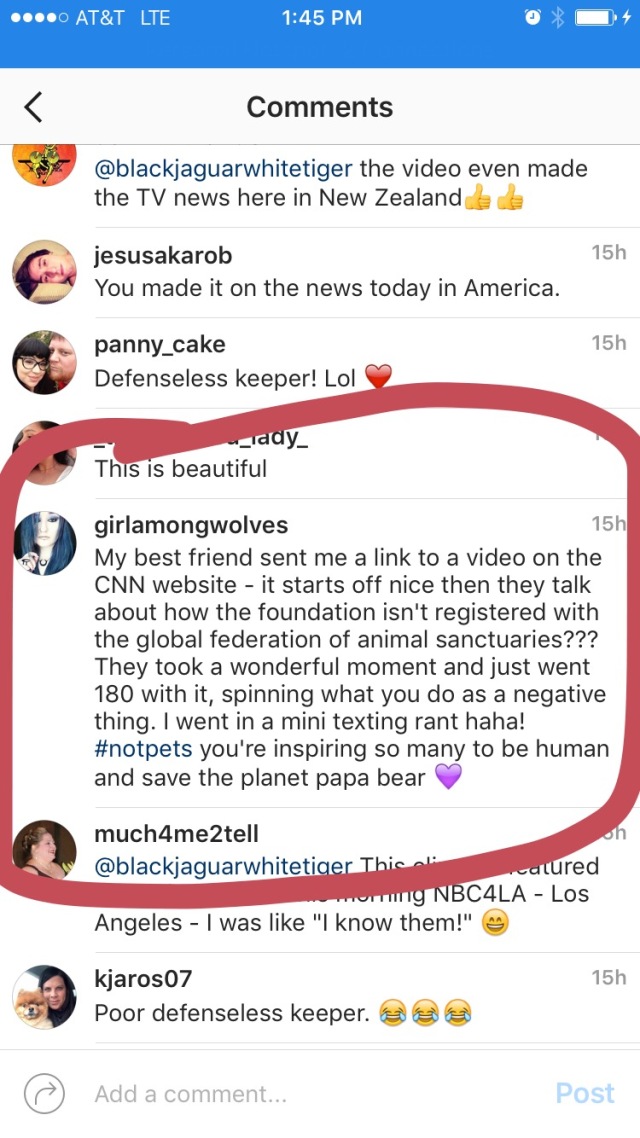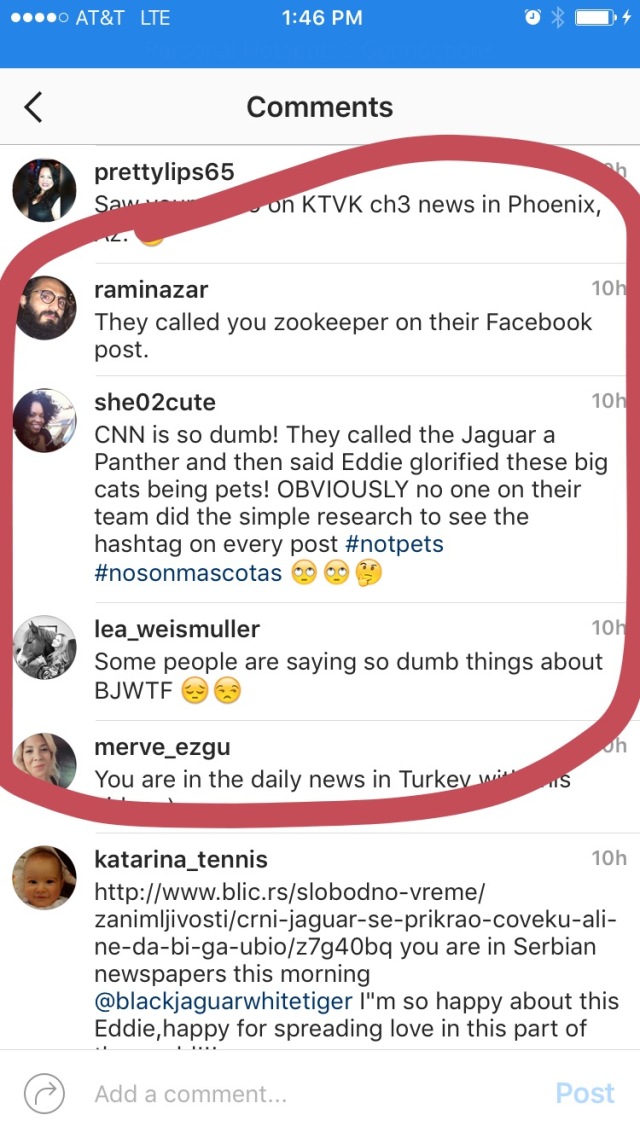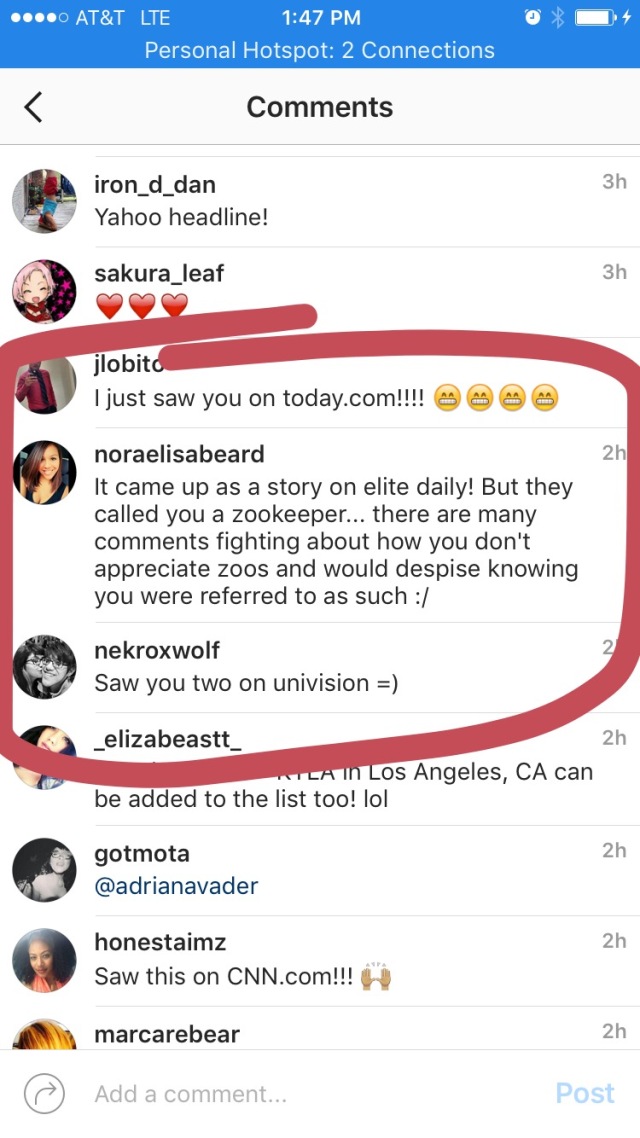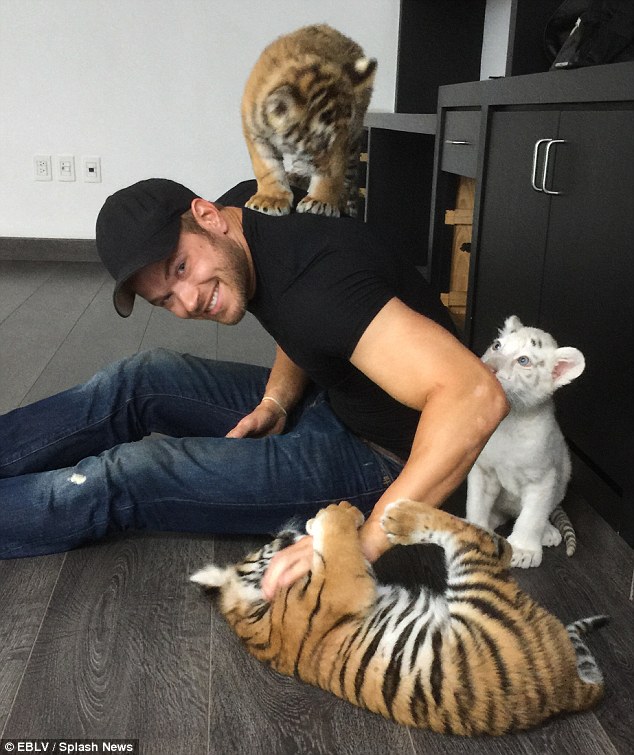I had an unexpected day off, yesterday, and I fully intended to use it to get much needed writing on novels done. However, I made the mistake of checking the I.C.A.R.U.S. email account first, and that’s when things ground to a halt. There, across the Yahoo news page, was yet one more headliner with a video of Eduardo Serio of Black Jaguar White Tiger standing casually against a stone wall while a black jaguar stalks him. The headliner, like so many of the videos from BJWT which are shared on the internet, made a joke of the fact that Serio was being stalked by a jaguar.
A little research into this latest “media splash” revealed posts on Snapchat, made by Serio excitedly boasting “Yahoo Front Page :)”

and “Look who made it into Snapchat’s daily mail :)”

There’s also an Instagram post referring to the Snapchat email.
“About time that (tags snapchat staff using Instagram handles) cut a flower from their garden hahahahaha Love you guys. But really, about time :)”
Yes, it’s about time that Snapchat recognized how important Eduardo Serio is, how much he does for them by posting hundreds of videos of his “rescued” big cats to their site. Nothing says narcissism like multiple posts on multiple social media accounts boasting about how you’re featured on multiple social media and news sites. Not for anything virtuous, but because you have a pet jaguar–who you insist isn’t your pet–stalking you like a house cat chasing rolled up socks.
You see, this, is what Serio cares about more than conservation, more than animals, more than humans, more than anything on the entire planet: Himself. And his own media greatness.
While I was stewing and trying to convince myself to just move on and ignore the flippant and ignorant news blip, my sister sent me a text with a link to another news article by CNN, one which showed the very same video.
I followed it, of course, and then followed other links and came up with numerous stories, all branching from the same video utilized in the Snapchat daily mail that Serio was so appreciative of (though he made it clear that the honor was quite overdue, thank you very much) and unsurprisingly, most of the videos and news blurbs said nothing of the ongoing issues with the foundation. Nor did they mention Serio’s recent and very public threats against any group speaking out in opposition to his foundation.
Only two stories I found, Chloe Bryan’s Mashable blurb, and Jeanne Moos’s CNN “backstory” clip, address the fact that handling big cats like they’re pets might not actually be the best thing to do in the name of conservation.
While Ms. Bryan’s blurb does cite at least two articles relating to problems that have been raised in regard to BJWT, and Ms. Moos’s clip features a brief statement from Kelli Heckman of the Global Federation of Animal Sanctuaries (which have set the standards the I.C.A.R.U.S. team uses when referring to sanctuaries as genuine, or pseudo) and does link to one, older article questioning BJWT, neither the blurb or backstory address the deeper issues of someone utilizing hundreds of animals in order to make themselves famous. Nor do they mention the fact that Serio’s “fierce critics” as Ms. Moos refers to them, are the focus of daily death threats, and threats of legal attack, or physical abuse–by not only Serio himself, but also the millions of followers he wields like a club in defense of his own actions. Neither article, while they question Serio’s practices, point out that he’s also a bully, who regularly threatens American citizens, along with citizens of other countries, when they disagree with him. Chloe’s article has already been inundated with BJWT followers criticizing her, threatening her, informing her of how wrong she is about BJWT, and defending both Serio, and BJWT.
Other stories, like this one put out today by Fox News offer nothing at all, even suggesting that keeping big cats as pets is a bad idea, aside from a one-liner at then end saying that they can’t endorse kissing a jaguar, but they do think you should check out the video.
Yes, by all means, check out that video of someone exploiting an animal, and share it.
Give the guy in the video more attention, and more reason to keep hoarding animals and calling it conservation. You’ve just secured the fate of countless more animals to captivity.
Animals like the most recent batch of cubs, most of whom were intentionally removed from their mothers for no reason–as Serio has admitted that the some of the mothers are owned by a friend and in no danger. Animals like “Arizona” the tiny tiger cub seen aspirating and nearly drowning in milk while being improperly fed in this video, which has since been deleted. Weeks after that video surfaced, and was subsequently deleted, Serio announced that Arizona is now having health issues, including “seizures” which he blames on “inbreeding”.
We’ll never know precisely what’s wrong with Arizona. However, aspiration pneumonia due to improper feeding techniques is considered one of the highest risks associated with hand raising captive big cat cubs, and it can cause seizure or tremors as well as dehydration.
According to Ron Hines, DMV PhD:
“The most serious problem that can occurs for an inexperienced caregivers (or a distracted or rushed experienced caregivers) is allowing the milk formula to enter the cub’s lungs rather than its stomach – the formula “goes down the wrong way”.
The most common cause of this is feeding infant cubs in the wrong position. Never cradle and feed these exotic cats on their back as you would a human infant. These animals must have their stomach side down (belly down) when they suckle. Later, when the cub is more developed and able to walk, it can sit back on its haunches or stand and take the bottle in its front paws like the one in the photograph at the top of this article.
The younger a cub is, the more likely this problem is to occur. That is why inexperienced caregivers are much safer if they take over the chore when cubs are already 4-6 weeks old. Let an experienced person get you started right.
Here are some other tips to help you prevent this problem:
Feed the baby in the proper position
Use nipples that are the right size and that do not leak or flow too easily. (Pull on the nipple to be sure it is well seated. Enthusiastic cubs will pull nipples right off the bottle and can swallow them.)
Never squeeze the bottle when the cub is nursing
Be sure you stop feeding the cub as soon as it no longer sucks vigorously and greedily. Do not punch too many holes or too large a hole in the rubber nipple. Milk should not drip or accumulate on the bottle when it is held nipple-down.
Milk should never come out a cub’s nose.
Once a cub has aspirated, there is very little a veterinarian like me can do to improve its chances of surviving.
Symptoms of aspiration pneumonia are labored breathing, irregular breathing, gasping, pale or bluish gums. Later, tremors and listlessness and death.”
From the AZA website relating to the hand rearing of cubs (which it counsels against doing, unless the cub’s life is at stake):
“When feeding young felids, they should be placed on their stomach on a flat surface (e.g., table). Cubs held in an upright or head back position during feeding are more prone to aspiration and death.”
And a recent article on Tublr by Big Cat Awareness which cites AZA standards for the hand feeding of big cat cubs and showcases the GFAS standards such as:
“Humans do not enter enclosures with felids. Direct physical interaction is limited to protected forms of contact, by experienced personnel, to minimize the risk of injury.
No direct contact between the public and felids occurs.”
After seeing Arizona aspirate enough milk that she regurgitated it through her nose, none of us who have even the most remote experience with hand rearing felids (domestic, or captive wild) are surprised to hear that she is now having health problems. But BJWT fans seem incapable of linking the fact that Arizona was improperly fed, choked on milk, and subsequently aspirated it, with the fact that she’s now having seizures, which could well be directly caused by the aspiration of the milk. And with Serio blaming “inbreeding” for practically every health care issue he admits an animal has, no scientific information on the risks of his continued hand rearing is being offered to the public who adores him.
It does not help, that media outlets so often just merely brush against the larger topics within their stories, without ever *actually* taking a stand on the matter.
The “backstory” Ms. Moos did for CNN can be broken down to a few sentences:
Eduardo Serio has hundreds of cats who love to kiss him. He has supporters and critics. Lots of celebrities love him because they get to pet big cats. Kelli Heckman says it’s a bad idea, and GFAS says it’s the wrong message. He says he rescues them from circuses and breeders. We couldn’t speak to Serio for the story.
Where, in that article is an actual position on the matter? There isn’t one.
Now, before anyone can say that it’s not the news media’s place to say something is right or wrong, I understand that in this modern era, the “shell game” of responsibility is stronger than ever. But it wasn’t always that way. It used to be that when a news agency reported on something, it was with an intent on ferreting out the truth behind that story, be it a good truth, or a bad truth. And then they stood with the researched truth. Now, that’s not the case. The internet is comprised of “fluff” pieces that either circumnavigate connotations of “good” and “bad” entirely, or arrange a few partial facts and leave the public to sort them out.
Ms. Moos included footage of celebrity “supporters” of BJWT, and she including an “expert” from the GFAS stating that what Serio does is not real conservation. However, she either didn’t research enough to find, or chose to omit facts such as celebrities lashing out at those who try to inform them that they’re participating in bad pseudo-conservation


or the fact that Serio has publicly attacked and threatened to destroy groups, “fierce critics” in Ms. Moos’ words, who speak out against him:


And while Ms. Moos raised questions about where those animals came from, she did not mention the fact that Serio has admitted to buying directly from breeders, and private zoos, or that buying from breeders directly supports the captive breeding of big cats.
This leaves the news media in the very safe position of, well, not actually having a position.
I am grateful to Ms. Moos for having contacted the GFAS and gotten a comment from them. I’m grateful that she brought into question the fact that BJWT is not accredited by the GFAS, and the fact that no one knows where all of those cubs are coming from. I’m grateful that she brought into question the practice of handling big cats as if they’re pets, and allowing celebrities to pet them. If Ms. Moos has interest in seeing firsthand how BJWT followers react to anyone asking even the most minimal questions (something we deal with on a daily basis) here are some of the responses to her own CNN backstory:



I particularly love the last one pictured wherein the commenter say Serio “doesn’t appreciate zoos”. Except for zoos bought by his friends, and from which he then takes more babies to hand raise so he can post more videos of himself playing with them. This is–in Serio’s own words–how some of the cubs he’s currently raising were secured. The first story he gave involved rescuing them from a zoo, and being unable to house the mothers of the cub. Later, however, Serio has admitted that one of his personal friends bought the zoo in question, which would indicate no great risk for the animals, and thus no real reason to remove them from their mothers.
Yes, Ms. Moos’s backstory is a start.
It is not, however, enough to even dent the ego and social media presence of someone who thrives off of being the center of attention on social media sites and in “fluff” pieces of news which only serve to promote him and his status. As of the writing of this article, the “cutesy, this is awesome” versions of the jaguar stalking video have spread around the world, being featured on news sites in Norway, Australia, Germany, Sweden, the UK, Serbia, Chile, Canada, Argentina, Brazil and nearly every state in the US. The video has been shared hundreds of thousands of times, if not millions. BJWT followers are hailing this as evidence of the spread of the “BJWT Nation” and a triumph for them.
A triumph for them.
Not the thousands of wild big cats slaughtered every year. Not the tens of thousands of big cats that languish in captivity. This media frenzy is not a “triumph” for any animal.
All of this attention goes strictly to one group. Eduardo Serio and his millions of worshipers. Which is exactly what Serio wants, and has always wanted. All of the attention on himself and his empire.
For those of us who actually care about animals, the fight against such horrendous misinformation as promoted in this article in the Irish Examiner, continues.
It bares saying that in this post:


Serio threatens those speaking out in opposition of him, saying that he has “unlimited amounts of money” with which to sue us–from another country–until we’ve been destroyed, and that he’ll use those unlimited funds to get rid of us. Yet in the Irish Examiner article it clearly states that he’s “trying to raise money to expand the size of the sanctuary”.
Now, either he has “unlimited amounts of money” or he doesn’t. Either he’s lying about how much money he has that he intends to use to sue those of us who publicly disagree with him, or he’s lying about needing the money to expand the foundation, but you can’t have it both ways.
What sort to “daily abuse” that those like the I.C.A.R.U.S. Foundation deal with am I talking about?
Here’s an example of the rants we deal with, in which Serio rails against “Project Imbecile” for “trashing him” while blatantly lying about the “two women” who comprise “Project Imbecile” (check our articles yourself, we never said what he’s accusing us of saying) and erroneously associates “Project Imbecile” with big cat groups in Tampa. He goes on to say that he’s been accused of using the tiger, Achilles, seen in this video, for publicity, which he claims isn’t true. Despite that he’s making a video about Achilles on social media while talking about how he isn’t using Achilles for publicity. Right after this section, Serio proclaims that the only real reason “Project Imbecile” hates him, is because he’s got 12k videos and photos posted on social media, and millions of followers, and we’re jealous.
Apparently, Serio bases expertise, and conservation on how many friends one has on social media, not what you actually do to aid conservation efforts. In Serio’s world, adding the hashtag #savetigers, or #savelions, or my favorite #notpets to videos of himself rolling around in his own bed with the aforementioned animals apparently somehow saves them, and shows people that they should never be treated as pets. I would link to the full length video, but I can’t find it. It’s either been deleted (something that happens often after a video has been posted) or it’s lost among the hundreds of videos posted since.
This is a vital point that Serio himself makes again and again, though.
He’s successful on social media and has millions of followers, and that is why he has “haters” who question his practices.
To Serio, it’s not about conservation of animals, about proper handling techniques, about captive big cats or about how they aren’t pets. It’s about the fact that he has millions of followers.
It’s about the fact that because he has millions of followers on social media sites, companies are willing to donate products, or services, to him, not because they care about the animals, but because they know that Serio’s followers will eagerly buy and support products that Serio uses and associates with, which will bring them a boost in sales, and money. It’s about the fact that for every one article that raises questions about BJWT, hundreds of ignorant articles are shared celebrating them, and erroneously likening the exploitation they use to a “special bond” never realizing that the animals featured have been hand reared and specifically selected just to be used in those videos. Articles like this one from Today, actually categorize the video and article under “pets” not conservation, something that is actually truthful.
Nothing BJWT does, aside from the ubiquitous hash tagging, has anything to do with conservation. It has to do with pets, and animal exploitation.
This is capitalism at its finest. We’re right back to kids buying Wheaties for no reason besides the fact that there is a celebrity they love on the box. Only in this case, the advertisement isn’t to become a star athlete. The message in this case, is to pet, coddle, play with and fawn over dangerous big cats as if they were pets. It’s to overlook the fact that by buying cubs from breeders, you’re supporting the breeding of captive big cats. It’s to be one of the “cool crowd” and play with big cats like celebrities do. It’s to exploit animals which do not belong in captivity, and would not be there except for people like Eduardo Serio who keeps them like pets, and promote the act of doing so.





























 in order to mimic their natural situation. The ICARUS groups considers this sort of handling to be part of the rehabilitation process, and thus unavoidable. However, romping around with big cat cubs, or dressing young primates up in clothing and carrying them around as if they were human children, crosses the line into pseudo-conservation. Continuing intimate contact with animals after they have matured beyond the necessity of that interaction is no longer caring for them as if they were wild animals, but instead, is treating them like a pet.
in order to mimic their natural situation. The ICARUS groups considers this sort of handling to be part of the rehabilitation process, and thus unavoidable. However, romping around with big cat cubs, or dressing young primates up in clothing and carrying them around as if they were human children, crosses the line into pseudo-conservation. Continuing intimate contact with animals after they have matured beyond the necessity of that interaction is no longer caring for them as if they were wild animals, but instead, is treating them like a pet. or playing inside houses with celebrity guests
or playing inside houses with celebrity guests








